
The Warrior knife is a large curved blade fighting knife with a serrated back edge that was first made by Al Mar Knives and Round Eye Knife and Tool (REKAT). Part of the knife's design is credited to martial arts instructor Michael Echanis.

The Warrior knife is a large curved blade fighting knife with a serrated back edge that was first made by Al Mar Knives and Round Eye Knife and Tool (REKAT). Part of the knife's design is credited to martial arts instructor Michael Echanis.
The Warrior knife was designed by custom knife maker, Vietnam combat veteran, and close combat instructor Bob Taylor and Hwarang-do expert Randy Wanner. [1] The blade is distinctive in that the entire rear portion of the blade has a serrated edge, that was added at the suggestion of Wanner's Hwarang-do student Michael D. Echanis and is the reason why the knife has the informal name "Echanis' Warrior". [2] [3] Al Mar was an edged-weapons specialist in the U.S. Army Special Forces, a 5th degree black belt in Judo when he started Al Mar Knives in 1978 and began work on the famous and highly sought after "Warrior" knife. In his book, Battle Blades, Greg Walker[3] refers to the Al Mar Warrior as, "perhaps the ultimate in battle-blade design.
In addition to the rear serrations used for trapping an opponent's attacking limb, the knife is noted for having an extremely ergonomic handle for use in both the forward and reverse grip. The handle was designed by making a complex study of the human hand through a COBOL computer program and this design has gone on to influence other fighting knives such as Emerson Knives' CQC-8 model. [4]
The original version was made by Al Mar Knives and had either a polished or blackened blade with either a black or camouflage rubber handle. [3] G.Sakai of Seki Japan was the manufacturer of the Al Mar Warrior as well as Spyderco's version.
Round Eye Knife and Tool made a smaller version known as the "Hobbit Warrior" and a folding version known as the "Pocket Hobbit". [5] [1]

A knife is a tool or weapon with a cutting edge or blade, usually attached to a handle or hilt. One of the earliest tools used by humanity, knives appeared at least 2.5 million years ago, as evidenced by the Oldowan tools. Originally made of wood, bone, and stone, over the centuries, in step with improvements in both metallurgy and manufacturing, knife blades have been made from copper, bronze, iron, steel, ceramic, and titanium. Most modern knives have either fixed or folding blades; blade patterns and styles vary by maker and country of origin.
Rex Applegate was an American military officer who worked for the Office of Strategic Services, where he trained Allied special forces personnel in close-quarters combat during World War II. He held the rank of colonel.
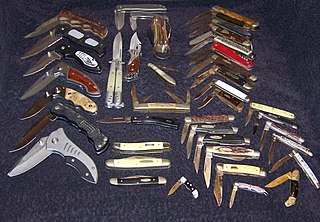
A pocketknife is a knife with one or more blades that fold into the handle. They are also known as jackknives (jack-knife), folding knives, EDC knife, or may be referred to as a penknife, though a penknife may also be a specific kind of pocketknife. Blade lengths typically range from 5 to 15 centimetres. Some pocketknives have multiple tools in addition to one or more blades.
Spyderco is an American cutlery company based in Golden, Colorado, producing knives and knife sharpeners. Spyderco pioneered many features that are now common in folding knives, including the pocket clip, serrations, and the opening hole. Spyderco has collaborated with 30 custom knife makers, athletes, and self-defense instructors for designs and innovated the usage of 20 different blade materials.
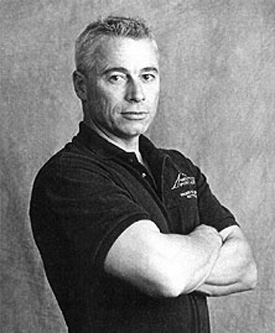
Ernest R. Emerson is an American custom knifemaker, martial artist, and edged-weapons expert. Originally an engineer and machinist in the aerospace industry, Emerson became a knifemaker by producing knives for a martial arts class and making art knives early in his knifemaking career. In the 1980s he became better known for his combat knives and popularizing a style of knife known as the Tactical-folder.
A combat knife is a fighting knife designed for military use and primarily intended for hand-to-hand or close combat fighting.
The Gerber Mark II is a fighting knife manufactured by Gerber Legendary Blades from 1966 to 2000, with an additional limited run of 1500 in 2002, and full production resuming as of July 2008. It was designed by retired United States Army Captain, Clarence A. “Bud” Holzmann, who based the pattern on a Roman Mainz Gladius.
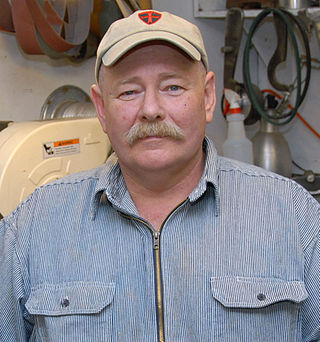
William Harsey Jr. is an American knifemaker and designer who works with several knife companies, including Gerber Legendary Blades, Lone Wolf Knives, Spartan Blades, Ruger/CRKT, Fantoni, and Chris Reeve Knives.
A knife fight is a violent physical confrontation between two or more combatants in which one or more participants are armed with a knife. A knife fight is defined by the presence of a knife as a weapon and the violent intent of the combatants to kill or incapacitate each other; the participants may be completely untrained, self-taught, or trained in one or more formal or informal systems of knife fighting. Knife fights may involve the use of any type of knife, though certain knives, termed fighting knives, are purposely designed for such confrontations – the dagger being just one example.
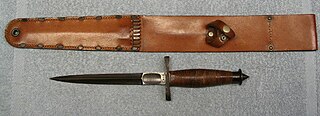
The V-42 stiletto was a fighting knife issued during World War II to the First Special Service Force, a joint American/Canadian commando unit.

The Linerlock is a locking mechanism for folding pocket knives. A Linerlock is a folding knife with a side-spring lock that can be opened and closed with one hand without repositioning the knife in the hand. The lock is self-adjusting for wear. The modern Linerlock traces its lineage to the late 19th century, but in the 1980s the design was improved by American custom knifemaker Michael Walker.

SOG Specialty Knives, Inc. is an American knife and tool manufacturing company famous for their reproduction SOG Knife from the Vietnam era.
Michael Dick Echanis was an American enlisted soldier and self-styled "soldier of fortune". In 1970, he served briefly in "C" Company, 75th Ranger Regiment Infantry in Vietnam. Echanis then made his living as a martial artist, writer and editor. He was the martial arts editor for the magazine Soldier of Fortune (SOF) from 1974 to 1976. He died while working as a private security contractor in Nicaragua at the behest of the Nicaraguan National Guard. This was reported by SOF in an article published after the incident.
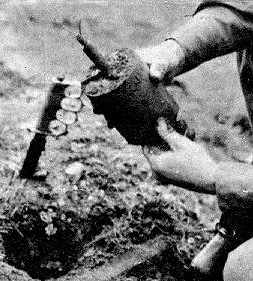
The Mark I trench knife is an American trench knife designed by officers of the American Expeditionary Force (AEF) for use in World War I. It has a 6.75 in (17.1 cm) double-edged dagger blade useful for both thrusting and slashing strokes, unlike previous U.S. trench knives such as the M1917 and M1918. The handle is made of cast bronze and uses a conical steel nut to hold the blade in place. The Mark I's blade was blued with a black oxide finish, the bronze handle was chemically blackened, with cast spikes on the bow of each knuckle. The spikes were intended to prevent an opponent from grabbing the knife hand, as well as to provide a more concentrated striking surface when employed in hand-to-hand combat.

The CQC-6 or Viper Six is a handmade tactical folding knife with a tantō blade manufactured by knifemaker Ernest Emerson. Although initially reported as the sixth design in an evolution of fighting knives and the first model in the lineup of Emerson's Specwar Custom Knives, Emerson later revealed that the knife was named for SEAL Team Six. It has a chisel-ground blade of ATS-34 or 154CM stainless steel and a handle made of titanium and linen micarta. The CQC-6 is credited as the knife that popularized the concept of the tactical folding knife.
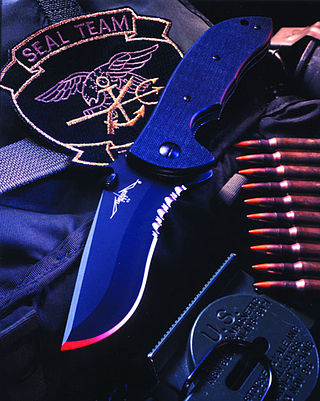
The Commander (knife) is a large recurve folding knife made by Emerson Knives, Inc. that was based on a custom design, the ES1-M, by Ernest Emerson that he originally built for a West Coast Navy SEAL Team. It was winner of the Blade Magazine Overall Knife of the Year Award for 1999.

Al Mar Knives is a production knife company headquartered in Tualatin, Oregon, United States. Al Mar Knives was established in 1979 by Al Mar, and has a reputation for making tactical knives of innovative design. While headquartered in the United States, Al Mar knives were made in Seki City of Japan from 1979 to 2019.
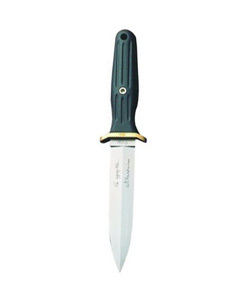
The Applegate–Fairbairn fighting knife is a combat knife designed by Colonel Rex Applegate and William E. Fairbairn as a version of the Fairbairn–Sykes fighting knife. The blade has a similar double-edged dagger profile, but is wider and more durable. It features a different handle, made most commonly of Lexan plastic with adjustable lead weights which can change the knife's balance-point. Later models and some custom variants included weights made from pure Teflon, tungsten, stainless steel and aluminum. The blade profile was also changed from a V-grind to a convex, or "appleseed" profile. While this changed the effectiveness of the blade in puncturing, cutting and slicing, it does not lend itself to being sharpened in the field by an inexperienced user. The current production model made by Böker in Solingen, Germany, uses a fiberglass reinforced delrin handle which solves the issues with earlier models where the handle would crack if exposed to heat.

A fighting knife has a blade designed to most effectively inflict injury in close-quarters physical confrontations. The combat knife and the trench knife are examples of military fighting knives.
Robert G. Terzuola is an American knife maker who popularized the type of knife known as the tactical folding knife.